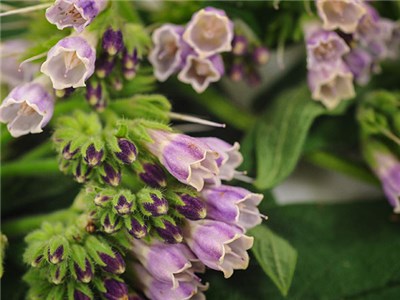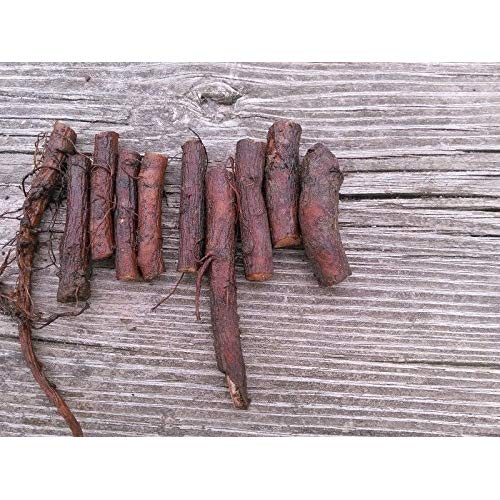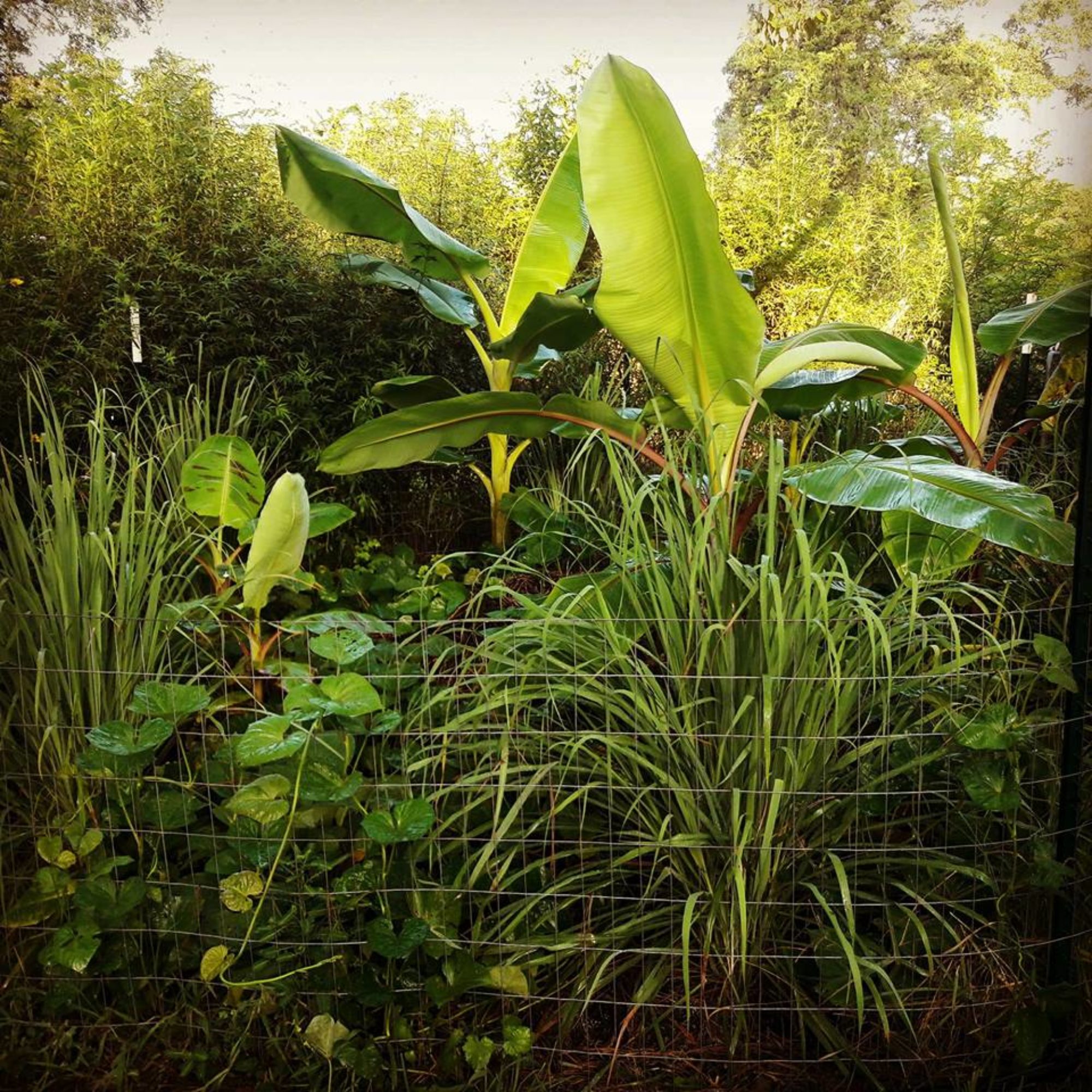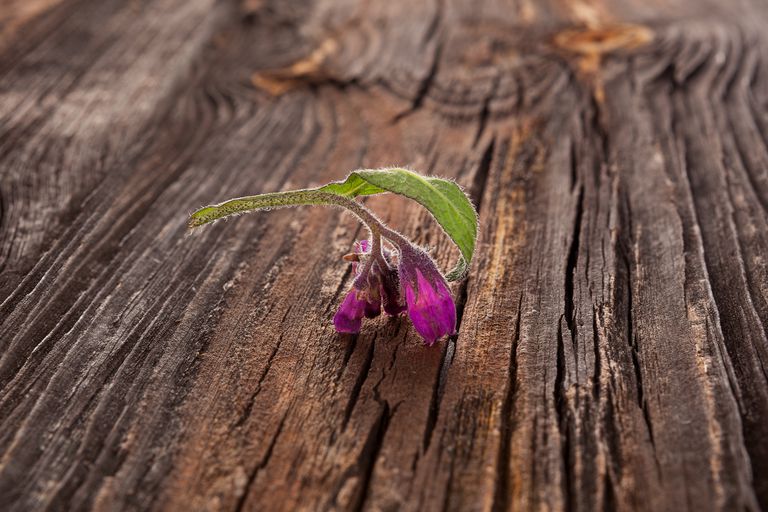Comfrey – A Most Useful Plant in Edible Landscapes!
Even though comfrey is not edible, it is still considered one of the most useful plants in an edible landscape. It has the ability to gather nutrients from deep within the soil, bring it to the surface and make it bio-available for surrounding plants; it is a come and cut again crop, producing up to 4 harvests per year and can be used in medicine and for mulch. Comfrey is the ultimate permaculture plant!
Types of Comfrey
There are 2 main types of comfrey. True comfrey, symphytum officinale, is the wild variety of comfrey and has fertile seed. Russian comfrey, symphytum uplandicum, has many different sub-varieties, usually marked by the name “Bocking” and then a number, corresponding to the trial in which it was developed. The most popular among the bocking varieties is Bocking 14 and then Bocking 4. The main difference between officinale and uplandicum is the fact that uplandicum does not produce viable seed and is therefore sterile, only reproducing by root division.
People will argue the benefits of 1 type over the other and even 1 variety of Russian comfrey over others, but they are mostly the same. There is some variance in the amount of allantoin, protein and PAs in each variety, but in my opinion, for everyday homestead use, the variances are minimal and not to be too concerned with.
Personally, I like the Bocking 14, as it’s the highest in allantoin, high in protein and, since it’s a hybrid variety, sterile, meaning it won’t be spreading itself all over the place via wind or birds. If I want more, propagation is easy, as we’ll discuss below.
Uses in Medicine
Comfrey is traditionally known as “knit-bone” because of it’s amazing ability to assist with cell regeneration and expedite wound healing. Comfrey has been taken internally for thousands of years but has recently been banned from use internally, or more accurately, herbalists have been banned from recommending internal applications.
The reason for this is its pyrrolizidine alkaloids, which is toxic and in high enough doses over long enough periods can become toxic to humans and lead to liver damage. Because of this, comfrey is rarely used internally any longer. It should be noted, however, that different parts of the plant have different concentrations of PAs and the concentration also varies greatly (up to 16 times) depending on climate, time of year, part of plant (root, stem, leaf, flower) and the age of the part you’re using (whether new or mature). The root has much more PAs, while the leaves have the least. Thing is, though, the root also has much higher levels of allantoin, which is the medicinal constituent we are after. Young roots and leaves have more PAs (and allantoin) than older leaves and roots.
Another note, comfrey should not be used medicinally during it’s first year. Allantoin levels are greatly reduced in it’s first year and we’d like the plant to get established before using it. The second year and third years are actually the best time to harvest for medicinal use, although older plants are also just fine.

Herbal Actions
For information on and a complete list of herbal actions, click here.
- Astringent
- Demulcent
- Emollient
- Expectorant
- Mucilage
- Vulnerary
Recipe!
There are many ways to use comfrey, including making into a decoction or salve. However, in the spirit of keeping things simple and easy, we will discuss one of the easiest ways to keep comfrey ready to go as a wound dressing.
Take a few young leaves and lay out on a flat surface, with plastic wrap or something underneath. Smash or roll with pin to damage cell walls and release the mucilage (gel). Keep rolling until tissue is completely wilted and most all gel has been released. Fold into usable pieces of different sizes and stick in freezer. Once frozen, remove plastic wrap or foil and put in freezer bags until ready to use.
Roots are stronger medicine than leaves, but require a food processor to grind fine enough to make this preparation. Extraction via oil is also possible and if you need the plant right away and do not have access to a kitchen, you may just chew the leaves a bit and apply externally as needed.
Uses in the Edible Landscape
Comfrey is incredible in the permaculture or edible landscape! It has many benefits and uses that can all be realized multiple times throughout the year. Let’s take a look at some.
Grow comfrey and you have grown your own mulch. As mentioned above, this what’s called a “dynamic accumulator”. This means, thanks to its long roots, it will acquire nutrients that are not available at the surface and bring them up into the plants leaves. Once in the leaves, they leaf may be cut and used as mulch, where soil life makes these nutrients available for surrounding plants. Otherwise, as the leaf dies and falls to the ground, the same process happens automatically. This also makes comfrey a great compost activator!
Another use for comfrey in the edible landscape is it dense root mass and large leaves that casts heavy shade. This heavy shade not only shades the soil, but prevents weeds by not allowing light to penetrate under it’s leaves. The dense root mat also helps prevent weeds from penetrating into garden beds with runners.
Comfrey, even the sterile hybrid varieties, attract beneficial pollinators and predators that also help pollinate your productive fruit and nut trees or shrubs. This makes this a great companion plant.
Finally, comfrey is a fantastic animal forage! It is super high in protein and has an annual harvest that rivals just about anything on the planet!
How to Grow!
Growing comfrey is easy but there are some things we’ll want to consider in the southern landscape. Hence the name, Russian comfrey, we would be correct to assume that it doesn’t care much for our summer sun or heat. This makes itself evident as summer rolls in. Plants that get any amount of full sun will wilt in the heat. Don’t worry, they’ll perk back up once in the shade. For this reason, I have tried to plant all my comfrey in the shadiest spots I can find during the summer.
Planting
Since most of us will be propagating from root cuttings, I’ll instruct you for this method. Take a 1 inch cutting and plant it about 1 inch below the surface of the soil. Keep moist, but not wet. Shade is best. If it’s been planted in a sunny spot, keep shade-cloth or something over it to protect it until it’s established.
Care
Once plant begins to emerge, keep soil moist for the first few months until plant gets established. Comfrey does not need a lot of care, but do not allow soil to completely dry out during warm or hot days.
Harvest
Harvest as needed. You can harvest anytime, and plants can be completely cut to the ground 3 or 4 times a year depending on your growing season. They will regenerate immediately without any damage to the plant!
Post Harvest – Curing & Storage
No curing is necessary. If you need to save some harvest or you’ll be making an extraction, dry the leaves in a warm dry environment like a dehydrator or warm oven with the door open. Store until needed.
Propagation
Propagation is easy as well, even if you have the sterile bocking type. To make 1 plant into 50, simply dig up the plant and cut the root into as many 1 – 3 inch pieces as you need. No need to return the crown to the previous location, you have not gotten all the roots and new plants will emerge from where you dug up the mother plant. Plant the root pieces directly in the ground or in pots if desired. You should see new leaves beginning to emerge within a week or so!

That’s all about comfrey! What do you have to say about comfrey? Do you grow it? How do you use it?
[TheChamp-FB-Comments]

